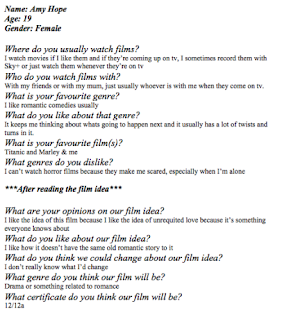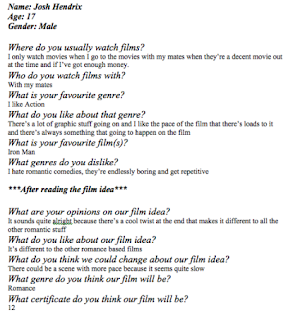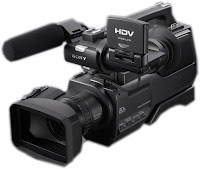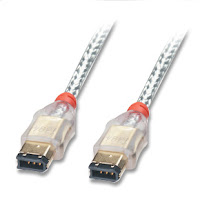Our media product was created to develop pre-existing
forms of conventions of real media products; we took the idea of quite a cliché
movie idea such as the typical "stalker" movies where the boy is
chasing after the girl, and the movie finishes when he either kills himself of
kills/rapes the girl who he is stalking. Our film develops on this otherwise clichéd
genre in that the girl who is being stalked in the first place is actually the
one who is stalking the male, and the story before we find out that the girl is
actually stalking him leads the audience into believing that the male is
actually the stalker, but as the movie comes to an end the audience will find
out that it was just a figment of her imagination and did not actually happen, it
was just an augmented reality that she created within her own head. We deliberately
subverted expectations, this relates to Steve Neale’s theory where the audience
expects the same genre, but with a unique difference or twist each time it’s
done to create excitement to keep the genre fresh, we replicated this idea with
our short film product. Barthes’
enigma codes also applies to our film in that we have a trail that the
audience have to follow and unravel clues as to what is actually happening;
this lures the viewer into watching it further to see what happens in the end.
Question 3)
What have you learned from your audience feedback?


These results were acquired as feedback to our original idea which we first started with, these also include audience research such as where and whom they watch films with. This helped us because it allowed us to think about the route we wished to take with our film and the different aspects of the genres that people like and the genres which people dislike. It helped us build on the idea of our film and cut out a few of the more romantic scenes so that it would transform the idea from a romance to a thriller/drama, playing on the cliched topic of the stalker. I tried to collect a variation of results from a number of people but there weren't many responses.
--------------------------------------------------------------------
This is the final poster we decided to use as an ancillary text.
The
poster was created to be somewhat creepy and to give an air of
mystery about the film. This is a blurred image of reality; this reflects our
film in that our initial aim was to make the audience see something that’s not
true at first, this can also be linked to Barthes’ enigma codes because it
creates a mystery that eventually gets unravelled, this will also be explained
in further detail on the next slide. The
main text on the poster is also slightly skewed further adding to the idea that
the main product is not quite right and there is something slightly different
to it. I also designed this poster so that the bottom shows darkness/black and
the top is much brighter which hints at the idea that there is contrast within
the film because there are two different sides to the proverbial coin.
The feedback we received about the poster reiterates these points and I believe that the opinions on the poster are quite correct in that it's supposed to appear as a stalker/pervert, it's good that the audience picked up on this as it suggests that our poster fits the purpose of why it was created.
-----------------------
We can take both negatives and positives from the feedback we have received so far; the feedback can be used to further refine the finished product to give a greater finish. To collect the feedback, I used the social networking website Facebook, which allows users to comment/like assorted posts. The link to the video was posted onto the site to allow people to view it and "like" and comment.
I agree with the first comment as the titles are quite repetitive and lack creativity, they're also too long. On the other hand, I like the effect it gives of a blurred reality, that the blurred images the audience are being shown aren't true or can be misconscrued into something else and the length adds the effect of an enigma, which is built upon as the short film goes on. Barthes' enigma codes establishes mysteries, drawing the audience into wanting to carry on watching the film so that they can solve these puzzles. This is the reason why the twist is at the end of the film; carrying on with Barthes' proposal of enigma codes.
Question 4) How did you use new media technologies in the
construction and research, planning and evaluation stages?
In the very first stages of construction of the product, I researched numerous other short films with a similar genre to ours.
How did digital technology enable you to develop creatively and are there examples of the technology obstructing or preventing your creativity?
Although the technology in the HDV-1000 allows it to have night-mode, the shots are way too green and are somewhat grainy, this is a look we did not want to show in our film so we decided to film in the day but edit it as if it were darker. This was achievable in the technology on the program "Final Cut Express" which has an effect called Colour Correcter which allows the colours/tones to be altered to the user's desires. Due to the erratic nature of the sunset in winter, our shots were either too dark or too bright; we have filmed in both daylight and the sunset, both of which aren't ideal because the daylight is too bright and the sunset is too quick and there is not enough time to do all the shots we would like in that time. In the first shot it is relatively dark, halfway through the shot is almost entirely black, therefore we can't use those shots.
So I came up with the idea to edit the shots using Final Cut Express to make simple bright days look as if it is night time. This will solve our problems with shots becoming too dark as they will ALL be shot in the daylight and edited the same to look as if it is at the exact same time. This will be rather simple and the final product shouldn't be too bad, although I assume some quality may be lost and it may not look like 'true' night, just dark blue. Although we will attempt to use the equipment and software to the best of our ability.
Although this will be pretty straight forward, I have found a simple tutorial on how this may be achieved. Using the same methods as the tutorial will be quick and enable us to get a half decent product. This may be the only way to make the daylight look as if it is night using this software. We can experiment with the software to try to get the best out of the film clip, although altering it in this way could lower the quality.
Embedded & Uploaded with Kiwi6
This is our final radio trailer which is approximately 37 seconds long. The new media technology I used to create this was a mixture of Final cut pro, where I arranged the sound clips and added numerous effects, and then I exported the audio using Wavepad sound editor to further refine the trailer. This was helpful because older technology wasn't built for such ease of use and it took much longer to finish a product.

The technology we mainly used was the combination of the HDV-1000, the camera, and a tripod to stabilize it. The camera in itself is quite easy to use and the interface is straight forward. Recording to a tape allows thee best quality to be transferred to the mac using a firewire cable. Although a few problems we encountered with this was when it rained the footage became very grainy and was barely usable so we had to re-shoot the same shot. Another drawback of using the HDV-1000 is the rate at which the focus shift. I would've like to incorporate some more shots using the focus but the ring had to be turned a ridiculous number of times before the focus shift became noticeable. The HDV-1000 cameras we used were somewhat cumbersome and the ability to move around with them is at a premium; they’re quite heavy and with the cost of the equipment we thought it would be a good idea not to do some shots that we were intending to do with fear of breaking them. One of the most helpful features of the tripod was the bubble which indicated whether the camera was perfectly straight on the tripod, this enabled us to refine the shot and minimise the tilt on the footage.
 The HDV-1000 camera we used to shoot the film. These were large and and rather cumbersome.
The HDV-1000 camera we used to shoot the film. These were large and and rather cumbersome. The firewire cables we used to "capture" the HD footage onto the Mac into Final Cut.
The firewire cables we used to "capture" the HD footage onto the Mac into Final Cut.








No comments:
Post a Comment